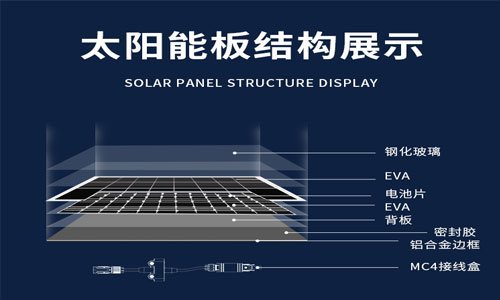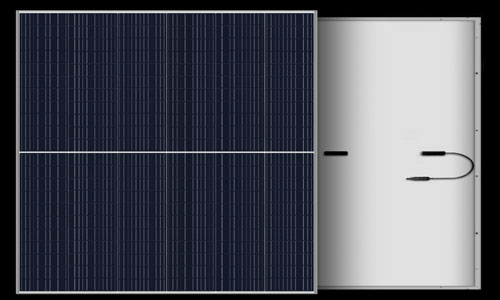A photovoltaic module refers to the smallest photovoltaic cell assembly that is enclosed and internally connected, capable of providing DC power independently and cannot be divided. It is the core component of a photovoltaic power generation system, consisting of eight core materials.

The solar cell is the most essential component of the module and is mainly used to convert light energy into electrical energy. The solar cells are connected in series and parallel to achieve a certain rated output power and voltage, forming a photovoltaic module. The photovoltaic modules are combined to form a photovoltaic array, which is connected to other components such as controllers, battery packs, and inverters to form a photovoltaic power generation system.
Solar cells are classified into monocrystalline silicon, polycrystalline silicon, and amorphous silicon solar cells according to the raw materials used. Monocrystalline silicon cells are based on silicon wafers and generate electricity by separating photo-generated carriers based on the PN junction. Depending on the difference in raw materials and cell preparation technology, monocrystalline silicon cells are divided into P-type cells and N-type cells. P-type silicon wafers are doped with boron in silicon material, and P-type cell preparation technologies include traditional AL-BSF (aluminum back surface field) and PERC technologies. N-type silicon wafers are doped with phosphorus in silicon material, and N-type cell preparation technologies include PERC, TOPCon, IBC, and HJT.
One of the N-type cells is the heterojunction cell, which has many advantages such as high conversion efficiency, high power generation, low temperature coefficient, no light-induced degradation and potential degradation, simple preparation process, and high double-sided power generation efficiency. With the continuous breakthrough in cell technology and the accelerated progress of the industry, heterojunction technology is expected to become the mainstream cell technology of the next generation.
02. Glass
Photovoltaic glass is a type of sodium-calcium-silicate glass mainly used for module encapsulation. Photovoltaic glass directly affects the power generation efficiency and service life of photovoltaic modules.
Photovoltaic glass is generally low-iron tempered glass or semi-tempered glass, which has the following characteristics. Firstly, it has good transparency. The transmittance is a key factor affecting the conversion efficiency of photovoltaic cells. Photovoltaic glass needs to have high light transmittance and higher reflectivity for 1200nm infrared light. Secondly, it has high mechanical strength. It is impact-resistant and can withstand 2400Pa wind pressure and 5400Pa snow pressure, providing support and protection. Thirdly, it has good durability. Considering the influence of climate and geographical location, modules need to operate in outdoor environments with large temperature differences between day and night. Therefore, the glass should have characteristics of corrosion resistance and weather resistance.
03. Encapsulant Film
The photovoltaic encapsulant film is an important component of photovoltaic modules and is located on both sides of the solar cells. The primary purpose of the encapsulant film is to bond the cells to the glass and backsheet. Additionally, the encapsulant film provides protection for the cell circuit, preventing interference from the external environment and extending the module's service life. Moreover, the encapsulant film enhances the transparency of photovoltaic modules, thereby improving their power generation efficiency. Lastly, the encapsulant film provides structural support during the production, storage, installation, and use of the module and helps position the cells.
In terms of materials, the main encapsulant films include EVA, POE, EPE, and PVB. EVA film is the mainstream encapsulant film for photovoltaics, characterized by good transparency, processability, stable supply, and low cost. However, it has some disadvantages such as high water vapor permeability, low impact resistance, and unstable resistance to potential-induced degradation (PID). POE film has lower water vapor transmission rate and better PID resistance, suitable for the encapsulation of double-glass and N-type modules but has poor processing properties and high cost.
04. Backsheet

Photovoltaic backsheet is a protective packaging material used on the backside of the module, usually for single-glass modules. Photovoltaic backsheets can be classified into fluoropolymer backsheets and non-fluoropolymer backsheets. Fluoropolymer backsheets include TPT, TPE, TPC, and CPC, while non-fluoropolymer backsheets include PET, PA/PO, etc.
The key function of the photovoltaic backsheet is to resist the corrosion of the environment, such as humidity and heat, to the solar cells, encapsulant film, and other materials. It provides corrosion resistance, weather resistance, oxidation resistance, and insulation protection, effectively extending the module's service life. A white backsheet has a high reflectivity, which can enhance the module's conversion efficiency. Additionally, high infrared reflectivity helps reduce the working temperature of the module.
05. Frame
The photovoltaic frame is installed around the edges of the glass and is mainly used to fix and seal the solar cell module, facilitating transportation and installation. The installation of the frame protects the edges of the glass, enhances the sealing performance of the photovoltaic module. At the same time, the frame serves as a connecting carrier between the module and the support structure, improving the overall mechanical strength and load capacity of the module, thereby extending its lifespan.
06. Tabbing Ribbon
The photovoltaic tabbing ribbon is a composite conductive material that is formed by coating a tin-based solder flux on the surface of a copper ribbon. It is used for series connection or parallel connection of solar cells in the module and plays a role in collecting and conducting current during the module welding process.
Photovoltaic welding tape is divided into interconnect welding tape and bus welding tape. The interconnect welding belt is used to connect photovoltaic cells and collect and transmit the current of photovoltaic cells. The junction welding tape is used to collect the current generated by the battery string and draw it into the junction box. The welding tape has a direct effect on current collection, which in turn affects the power and generation efficiency of the component.
The early use of the industry is flat welding tape, with the development of the industry, the current efficient components are using round welding tape.
07. Silicone
Silica gel is mainly used for bonding and sealing laminated glass photovoltaic modules, bonding the frame and glass, junction box and backplane (or glass), to seal and connect.
According to the different use of the location, silicone is divided into sealant and potting glue. The sealant is used in the frame card slot and the bottom of the junction box and the backplane. The potting glue is generally used inside the junction box, and its main function is to protect the internal circuit of the junction box.
08. Junction box
Junction box is mainly composed of junction box cover, sealing ring, diode, cooling device, box body, wire and connector. The main function of the junction box is to connect the electricity generated by the solar cell to the external line. It can seal, waterproof and dust-proof the photovoltaic module lead line. The junction box also protects the safety of the operation of the photovoltaic module system. If the component is short-circuited, the junction box will automatically disconnect the short-circuit battery string to prevent the entire system from being burned out.
The development and widespread adoption of photovoltaic (PV) systems require efficient manufacturing processes to produce high-quality components. Die-cutting has emerged as a promising solution for shaping PV modules with precision and accuracy.
Die-cutting technology offers numerous advantages in the fabrication of PV components. It enables the precise cutting of various materials used in PV systems, such as solar cells, back sheets, and encapsulation films. With customizable die designs, manufacturers can achieve the desired shapes and sizes for different module types, ensuring optimal performance and compatibility with installation requirements.
One of the key benefits of die-cutting for PV module production is its high efficiency. The process can be automated, resulting in fast and consistent production cycles. This not only reduces manufacturing time but also enhances the overall productivity of PV component fabrication. Additionally, die-cutting minimizes material waste, as it allows for precise cuts with minimal material loss. This contributes to cost-effectiveness and sustainability in the manufacturing process.
Die-cutting techniques also ensure uniformity and quality in PV module production. By using advanced die designs and machinery, manufacturers can achieve precise and clean cuts, avoiding any damage or defects to the components. This enhances the durability and reliability of PV modules, ensuring their long-term performance in various environmental conditions.
Furthermore, die-cutting offers flexibility in design and customization. Manufacturers can adapt the die-cutting process to accommodate different sizes, shapes, and configurations of PV modules, allowing for versatility in the production of both standard and specialized modules. This flexibility opens up possibilities for innovation and further advancements in PV technology.
In summary, die-cutting provides an efficient, precise, and customizable solution for shaping PV components in the manufacturing process. Its advantages include high productivity, material efficiency, quality assurance, and design flexibility. With the continued advancements in die-cutting technology, the production of PV modules can be further optimized, leading to improved performance, cost-effectiveness, and widespread adoption of solar energy.
Contact: Pamela
Phone: +86 189 6365 3253
E-mail: info@industryprocess.com
Whatsapp:+86 189 6365 3253
Add: Yajing Industrial Park, No. 59 Shuangjing Street, Weiting Town, Suzhou Industrial Park
We chat
